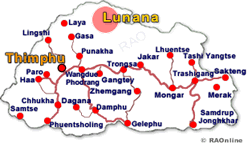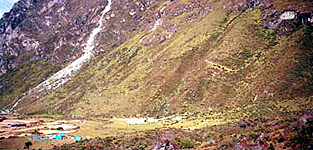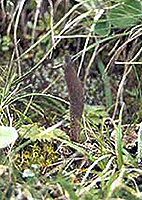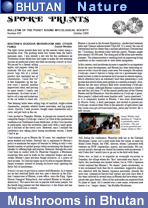| Cordyceps sinensis - Yartsa Goenbub in Bhutan |
| Highly
valued medicinal plant |
 |
Bhutan's Nature Yartsa Goenbub |
|
 |
Bhutan Information |
|
|
 |
| Yartsa
Goenbub collection legalised in Lunana |
 |
| Harvest of Yartsa Goenbub |
 |
 |
Villagers
of the remote geog of Lunana, Gasa dzongkhag, will be allowed to harvest
Yartsa Goenbub (Cordyceps Sinensis) a highly valued medicinal plant that
grows in the northern fringes of the country. Lunana is 4600 metres above
sea level. Yartsa Goenbub grows in meadows of sub-alpine to alpine regions. |
The
collection of Yartsa Goenbub is prohibited under the kingdom's forestry
act but the restriction was lifted for the people of Lunana following a
royal command. However, people in the other Cordyceps growing areas in
the country are still prohibited from collecting the plant.
Yartsa
Goenbub, literally meaning plant in summer, insect in winter is a rare
fungal species widely used in clinical medicine, as a household remedy,
and as an overall tonic. It is used largely by the Chinese and in Bhutan
by the institute for traditional medicine (NITM) in making traditional
medicines. Internet sources says that it is currently very popular due
to its use as an aphrodisiac (sex stimulant) and tonic.
|
Lunana
geog are eligible to harvest the Cordyceps |
 |
His Majesty commanded the agriculture ministry to look
into the possibilities of legalising the harvesting of the medicinal plant
in Lunana to serve as an additional source of income for the Lunaps. The
agriculture minister said that harvesting will be done in a sustainable
manner and collection will be stopped if sustainable harvesting is not
feasible. The Lunana Chimi, Gyem Tshering, said the lifting of restrictions
is a boon to the Lunaps.
The geog will form Tshogpas (committees) to collectively monitor the collection and growing areas, price, presence
of outsiders, and equality for all the Lunaps.
 |
| Lunana is 4600 metres above sea level |
A
protocol is being developed between the Gasa dzongkhag and the agriculture
ministry on the harvesting, transporting, marketing, and training on sustainable
harvesting of the Cordyceps in the geog. Among other things, the draft
protocol says that only the bonafide residents of Lunana geog are eligible
to harvest the Cordyceps. |
The
geog Tshogpas will be responsible for monitoring the presence of collectors
from other geogs and from across the northern border.
The
protocol also says that at least two of every five Cordyceps should be
left undisturbed as seed plants for regeneration.
The
Lunaps will sell their collection to the national institute of traditional
medicine (NITM), which has been identified as the authorised buyer.
 |
The
Gasa dzongda, Chencho Tshering, who has done a research on the Cordyceps
in Lunana geog said that legalising its collection would encourage the
Lunaps to participate in sustainable harvesting and protection of the rare
resource. He said that policing illegal collection of the plant was impossible
given the difficult terrain and weather. Bhutanese and outsiders alike
from across the border in the north have been illegally collecting Yartsa
Goenbub despite the ban.
Poachers
from across the border in Tibet enter Bhutan to collect the Cordyceps in
Soe, Lingshi, and Laya areas. The villagers however did not feel the responsibility
to alert the authorities, since they were not the stakeholders, he added. |
Chencho
Tshering said that a public meeting with the Lunaps discussed about identifying
Cordyceps growing areas, avoiding third party interference, fixation of
collection time, and sharing the common resources amongst the Lunaps in
an equitable manner.
Cordyceps
Sinensis is commonly found in the upper valleys of Phutey covering Thanza,
Tenchey and Tshodzong valleys. They grow in alternate years with peak seasons
lasting from end of May to July. Each stroma (one plant) weighs about 0.3
to 0.5 grams. Although the sale of Yartsa Goenbub was prohibited in Bhutan,
a kilogramme of Yartsa Goenbub is believed to fetch more than Nu 30,000
when sold across the border.
According
to the forest and nature conservation rule 2000, illegal collection of
Cordyceps can result in a fine of up to Nu 50,000 or three years imprisonment
or both.
 |
| This
article was contributed by Kuensel, Bhutan's national newspaper 2005 |
| Mushrooms in Bhutan |
 |
| Information on Bhutan |
 |
|
 |
| Please
take notice that RAOnline is not involved
in the business with Cordyceps sinensis products. |
|
|
|






